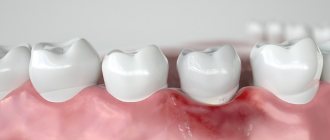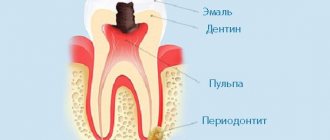Dental pin: what is it, its advantages and disadvantages
What is a dental post? This is a specialized dental structure that looks like a rod. It is installed into the tooth root as a support for a filling or crown. Installation of a pin is only possible if the tooth has a healthy root. As a rule, this design is used if the tooth is badly damaged and thin walls remain.
Advantages:
- reducing the load on the tooth root;
- the ability to restore the crown in just one visit to the dentist;
- ease of installation;
- high level of aesthetics of the future artificial tooth;
- relatively low cost.
Flaws:
- instability under heavy chewing loads;
- there is a risk of damage to the root walls;
- allergic reactions and the development of secondary caries are possible;
- metal rods can only be removed together with the tooth.
To successfully install the pin, the following conditions will need to be met:
- the length of the rod must be at least 2/3 of the length of the dental canal;
- the size of the rim of healthy tooth tissue is at least 2 mm;
- root canal treatment was carried out with high quality;
- the root canal was given a cylindrical or conical shape.
What is an implant
An implant (or implant) is a titanium rod that is screwed into the bone tissue in place of the lost tooth. It is shaped like a natural root. But this is not a finished tooth yet. To install a crown on an implant, you need a connecting link - an abutment. It is fixed to the implant, and a crown is already placed on it.
Most often, implants are made of titanium. This is a biocompatible material that practically does not cause rejection. For patients with metal allergies, zirconium dioxide implants are suitable.
All implants differ in size, shape and design features. A wide selection of models helps the doctor choose exactly the option that is suitable for your clinical case.
How is the implant installed?
Classic (two-stage) implantation lasts 5 – 6 months. First, the doctor installs the implant, and after 3–4 months he places the gum former. In another 2 - 3 weeks, after the gums have healed, an abutment and a crown will be placed. If implantation is performed in the smile area, then installation of a crown is possible immediately after surgery.
Sometimes an implant can be placed immediately after tooth extraction. This type of implantation is called one-stage implantation.
If a tooth has been missing for a long time, then an additional procedure may be necessary before implantation - bone tissue augmentation. The fact is that due to the lack of chewing load, the bone decreases, and it becomes insufficient for the implant to hold firmly and securely in the gum. In this case, another 3–4 months are required for engraftment.
How long does it take to install a pin and how painful is this process?
The duration of the procedure directly depends on the initial condition of the oral cavity. If there are no problems, the pin is placed in one visit to the dentist. If periodontal diseases and other pathologies are present, a pin will be installed in the tooth root only after they have been eliminated.
Since the doctor touches soft tissue during the implantation of the supporting element, the procedure is often accompanied by painful sensations. The occurrence of pain after nerve removal is a natural process. But if a long-depulped tooth hurts, it is possible that the rod has entered too deeply into the canal. X-rays will help identify the cause of the pain.
How to install a light seal
Dental treatment involves removing infected tissue (dentine, pulp), cleaning and sealing root canals. The restoration itself takes place directly in the oral cavity:
- The patient's eyes are protected from ultraviolet radiation by glasses
- the doctor selects the shade of the composite
- Apply it layer by layer to the tooth
- each layer is treated for 20 seconds with a special UV lamp
- polishes the filling, achieving perfect closure of the teeth
- polishes the surface to a natural shine
Indications and contraindications for installing pins
Indications:
- damage to the tooth crown by more than 50%;
- the need to create support for prostheses;
- tooth loss;
- weakening of the tooth due to dental diseases.
Contraindications:
- untreated caries;
- the presence of inflammatory processes in the area of the tooth root;
- root destruction;
- blood diseases;
- insufficient thickness of the root canal;
- the presence of caries and periodontal inflammation;
- granulomas, cysts;
- exacerbation of systemic diseases;
- pregnancy;
- allergy.
It is important to know. The choice of the most suitable type of pin is always up to the doctor. It is unacceptable to focus only on the cost of the dental structure.
When is it necessary to restore a damaged tooth?
The technology for restoring a damaged tooth determines the causes of the damage. Chips, cracks and breaks are formed due to:
The degree of damage depends on the causes:
- small chip or crack;
- destruction of more than 50% of the area;
- completely disappeared coronal part with an intact root.
All these cases are not critical. the ART dentistry doctors There are situations when dentists make a drastic decision and recommend implants. Probable reasons:
- the destruction goes deep under the gum;
- the tooth is loose;
- the root is severely inflamed and treatment is impossible.
In all other cases, doctors perform restoration, adhering to the unspoken rule that “our own is better than artificial.”
Pin Installation Procedure
How to install a pin in a tooth? The procedure occurs in several stages:
- Removal of all dental tissues affected by caries.
- Preparing the bed for the pin using a special reamer and calibration cutter.
- Root canal preparation.
- Fitting the rod to the tooth.
- Installation of the pin; dual-curing adhesive is used as a fixing element.
- Restoration work using a crown or prepared filling material.
The Saint-Dent Clinic in Moscow offers a wide range of dental services for adults and children. The current cost of services can be found here, the contact page is located here.
Advantages of filling at OneDent
- Specialists with more than 10 years of experience.
- High level of aesthetics: fillings installed in our clinic do not stand out in the dentition.
- Durable materials: restorations last more than 7 years (with proper care).
- Perfect fit and minimal shrinkage - no caries forms at the interface between the material and dental tissues.
- Affordable cost of services, options for any budget.
Installation example "Before and After"
Possible complications
- severe pain, swelling;
- root fracture;
- restoration chips;
- the occurrence of a local allergic reaction to the material from which the rod is made;
- development of the inflammatory process (stomatitis, periodontitis);
- cyst development;
- fistula formation;
- mechanical damage to the walls of the tooth, which can lead to perforation of the root canals;
- splinters from dental instruments getting into the root canal.
It is important to know. The most dangerous complication is rejection of the installed supporting element by the body. In this case, it must be completely removed from the oral cavity.
What material is used
It is a light-curing composite that hardens when exposed to ultraviolet light. As a result of using this material, it turns out that the installed filling is light. In its original form, it is plastic, so the doctor can accurately copy the anatomical shape of the tooth, restoring its missing part. The composition includes heliocomposite, glass ceramics, stabilizers, and pigments that give a certain shade.
Advantages:
- Absolute safety and hypoallergenic.
- Non-toxic
- Withstands significant chewing load.
- Excellent polishability.
- They have the natural shine of healthy tooth enamel.
- Suitable for all patients.
Certain types of composite materials (for example, LuxaCore) contain zirconium dioxide, so we use them to fix intra-canal pins, which allow us to restore severely damaged teeth.
What to do if a tooth with a pin hurts
In the first hours, rinsing the mouth with a soda solution (1 teaspoon of soda per glass of water) will help relieve toothache. A decoction of chamomile and sage has a similar effect. You can also take painkillers and apply ice to your cheek in the area where the pin was placed.
It is important to know. The occurrence of slight swelling and pain in the first days after installation of the pin is normal. But if these symptoms persist for a long time and the patient experiences an elevated body temperature, you should consult a dentist.
Consequences, pain and complications after prosthetics
After the preparatory stage, installation of a rod or fixation of a crown, some patients feel discomfort - mainly pain. It is due to the fact that during the process of cleaning the canals, installing an orthopedic structure, and using a retraction thread, the surrounding healthy tissues were slightly injured. Normally, pain subsides within 3-5 days, less often – within 3-4 weeks (if pulpitis in a chewing tooth was treated).
If the pain only intensifies, becomes unbearable, the gums become very red, and an unpleasant taste or smell appears in the mouth, then it is likely that complications have begun. They are associated with poor-quality preparation of canals, manufacturing and installation of structures, and non-compliance with sanitary rules. Therefore, you must definitely contact the dentist.
The most common questions about pins and answers to them
Is it always possible to get by with a pin?
Unfortunately no. In case of significant tooth decay, when there is a risk of further destruction of the coronal part, dental prosthetics are recommended.
How to care for your teeth after having a pin installed?
For two weeks, it is not advisable to eat too hard food and use toothpicks. When brushing your teeth, you need to be as careful as possible so as not to injure your gums.
Is there an alternative to a dental post?
Yes, you can install a stump tab instead. This is a microprosthesis, the lower part of which is fixed into the root canals, and the upper part serves as a supporting element for an artificial crown.
Do I need to put pins under crowns?
When understanding the questions of whether a crown is placed on a pin and whether it is possible to do without it, you need to understand why it is placed in the tooth at all. When a person bites off food or chews, the pressure is distributed along the crown, then goes to the root and bone of the jaw. This is a physiological process, and with healthy teeth we don’t even pay attention to it. In case of severe destruction of the natural tooth apex, the core will become an additional “line of force”, making the stump and root stronger. Whereas without a rod, the tooth under the crown will quickly break, even if it still has thin walls in which the filling was placed (the filling in this case will quickly sag or chip).
But if the apex is well preserved (70% or more) and pulp removal was not performed, then you can do without a pin. In this case, the tooth is “living”, it receives nutrition, and its own tissues (enamel and dentin) are sufficient for long-term support of the prosthesis.











